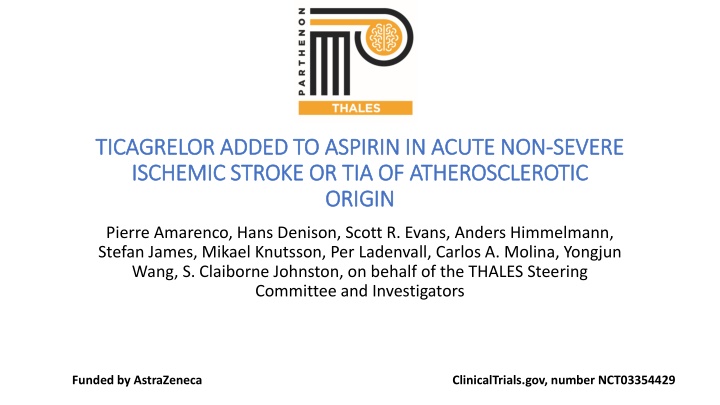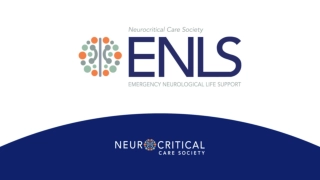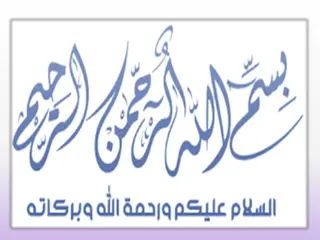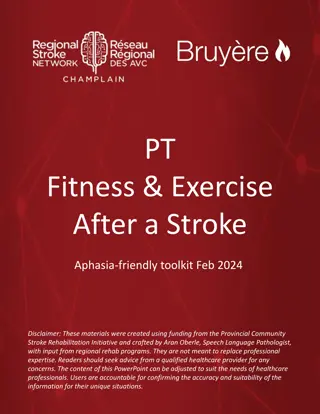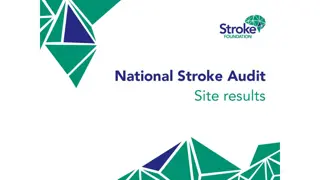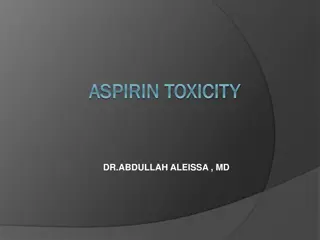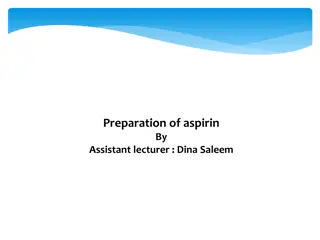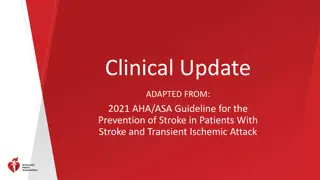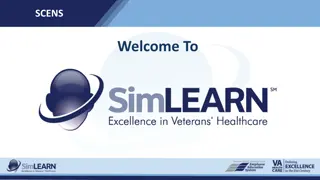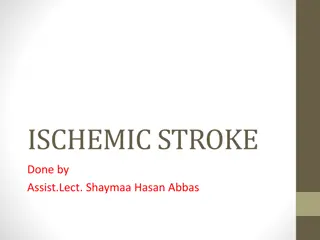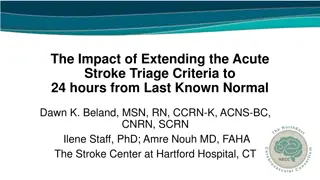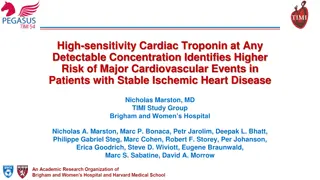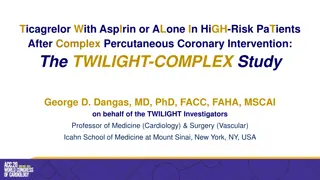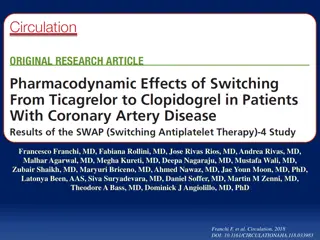Ticagrelor Added to Aspirin in Acute Non-Severe Ischemic Stroke or TIA of Atherosclerotic Origin
Among patients with transient ischemic attack (TIA) or minor ischemic strokes, adding ticagrelor to aspirin has shown superior efficacy in preventing stroke or death, particularly in those with ipsilateral atherosclerotic stenosis. The THALES trial demonstrated that ticagrelor added to aspirin was more effective than aspirin alone in reducing the risk of recurrent vascular events. This combination therapy could be beneficial for patients at high risk of vascular events, especially those with atherosclerotic origin. Various trials and studies have supported the use of ticagrelor in such populations, highlighting its potential in improving outcomes for patients with ischemic stroke or TIA of atherosclerotic origin.
Download Presentation

Please find below an Image/Link to download the presentation.
The content on the website is provided AS IS for your information and personal use only. It may not be sold, licensed, or shared on other websites without obtaining consent from the author.If you encounter any issues during the download, it is possible that the publisher has removed the file from their server.
You are allowed to download the files provided on this website for personal or commercial use, subject to the condition that they are used lawfully. All files are the property of their respective owners.
The content on the website is provided AS IS for your information and personal use only. It may not be sold, licensed, or shared on other websites without obtaining consent from the author.
E N D
Presentation Transcript
TICAGRELOR ADDED TO ASPIRIN IN ACUTE NON TICAGRELOR ADDED TO ASPIRIN IN ACUTE NON- -SEVERE ISCHEMIC STROKE OR TIA OF ATHEROSCLEROTIC ISCHEMIC STROKE OR TIA OF ATHEROSCLEROTIC ORIGIN ORIGIN SEVERE Pierre Amarenco, Hans Denison, Scott R. Evans, Anders Himmelmann, Stefan James, Mikael Knutsson, Per Ladenvall, Carlos A. Molina, Yongjun Wang, S. Claiborne Johnston, on behalf of the THALES Steering Committee and Investigators Funded by AstraZeneca ClinicalTrials.gov, number NCT03354429
Disclosures Disclosures I have received fees from AstraZeneca as an Executive Committee member of the SOCRATES&THALES trials Bayer as an Executive Committe member of the XANTUS registry, of Steering Committee of the ESUS trial Pfizer as an Executive Committee member of the SPIRE trials program Kowa as an Executive Committee member of the PROMINENT trial BMS as a steering Committee member of the AXIOMATIC-SSP trial Jansen as an advisory board member GSK as an Endpoint Committee member of the SUMMIT trial Fibrogen as a DSMB member of the ALPINE (Roxadustat) trials program Shingpoon as a DSMB member Amgen as an advisory board member and speaking activities I have received research grant support from French government for the TST and TST-PL.U.S. trials Pfizer for the TST trial Sanofi and BMS, and AstraZeneca for the TIAregistry.org Boston Scientific for the WATCH-AF registry
Background Background Among patients with a transient ischemic attack (TIA) or minor ischemic strokes, those with ipsilateral atherosclerotic stenosis of cervicocranial vasculature have the highest risk of recurrent vascular events.1 Ticagrelor is a potent, rapid acting P2Y12 inhibitor. Ticagrelor monotherapy was not superior to aspirin in SOCRATES trial (n=13,199) (NCT NCT01994720).2 However, in 3081 patients in the SOCRATES trial with ipsilateral atherosclerotic stenosis ticagrelor was superior to aspirin (6.7% vs 9.4%, HR 0.68 [0.53-0.88] P=0.003 ) while in 10,118 patients with no ipsilateral stenosis (6.8% vs 6.9%) HR was 0.97 [0.84-1.13] Pinteraction=0.017.3 In the THALES trial (n=11,016)(NCT03354429 ), ticagrelor added to aspirin was superior to aspirin alone in patients with TIA and minor stroke for the prevention of stroke or death (5.5% vs 6.6%, HR 0.83 [0.71-0.96], P=0.015).4 Our aim was to evaluate the efficacy and safety of ticagrelor added to aspirin in patients with ipsilateral atherosclerotic stenosis 1. 2. 3. 4. Amarenco P et al. One-year risk of stroke after transient ischemic attack or minor ischemic stroke. N Engl J Med 2016;374:1533-4 Johnston SC et al. Ticagrelor versus aspirin in acute stroke or transient ischemic attack. N Engl J Med. 2016;375: 35-43 AmarencoP et al. Ticagrelor versus aspirin in acute stroke or transient ischemic attack of atherosclerotic origin. Lancet Neurol. 2017;16:301-310 Johnston SC et al. Ticagrelor and Aspirin versus Aspirin in Acute Ischemic Stroke or TIA. N Engl J Med. 2020;383:207-217
THALES trial THALES trial - - Methods Methods Investigators informed on severity and location of atherosclerosis of the cervicocranial vasculature, and classified their patients according to ASCOD Atherosclerosis phenotype criteria into a group with and a group without ipsilateral stenosis,1 to perform this pre-specified, exploratory analysis. Outcomes were adjudicated by the investigators Analysis was by intention to treat. 1. Amarenco P et al. The A-S-C-O-D phenotyping of ischemic stroke. Cerebrovasc Dis. 2013;36:1-5
THALES Study Design N~11000 Study population: Ticagrelor 90 mg bid + ASA Standard of Care Acute ischemic stroke (NIHSS 5) OR R 1:1 High-risk transient ischemic attack (TIA) (ABCD2 6 or symptomatic arterial stenosis 50%) Randomized within 24 hours Patients 40 years Placebo bid + ASA Standard of Care Day1 Day 60 Day 30 Day7 Follow-up Period Study Treatment Period Key exclusion criteria: No cardioembolic origin No thrombolysis or thrombectomy No indication for antiplatelet other than ASA (aspirin) or for anticoagulation therapy No previous intracranial hemorrhage No planned carotid intervention within 3 days Ticagrelor dose: 180 mg loading dose day 1, followed by 90 mg BID day 2-30 Aspirin dose: 300-325 mg day 1, followed by 75-80 mg day 2-30 5
Endpoints Primary endpoint: Time to the first occurrence of any event in the composite of stroke (ischemic or hemorrhagic) and death Secondary endpoints: Time to the first occurrence of any ischemic stroke Safety endpoint: Time to first severe bleeding event (GUSTO definition) Exploratory endpoint: Disabling stroke (stroke event with mRS>1 at 30 days)
Patients Patients Baseline Characteristics with ipsilateral stenosis (N=2351) Ticagrelor+Aspirin (N=1136) 67.1 (10.7) 369 (32.5%) without ipsilateral stenosis (N=8665) Ticagrelor+Aspirin (N=4387) 64.7 (11.0) 1739 (39.6%) Aspirin (N=1215) 67.6 (10.5) 388 (31.9%) Aspirin (N=4278) 64.4 (11.2) 1783 (41.7%) Age yr Female sex % Race % White Black or African American Asian Other Qualifying event no. (%) TIA Ischemic stroke Time to randomization after onset of symptoms no. (%) <12 hr 12 hr 651 (57.3%) 4 (0.4%) 468 (41.2%) 13 (1.1%) 665 (54.7%) 6 (0.5%) 531 (43.7%) 13 (1.1%) 2322 (52.9%) 17 (0.4%) 1885 (43.0%) 163 (3.7%) 2283 (53.4%) 26 (0.6%) 1808 (42.3%) 161 (3.8%) 158 (13.9%) 978 (86.1%) 175 (14.4%) 1040 (85.6%) 333 (7.6%) 4054 (92.4%) 365 (8.5%) 3913 (91.5%) 356 (31.3%) 780 (68.7%) 375 (30.9%) 840 (69.1%) 1456 (33.2%) 2931 (66.8%) 1401 (32.7%) 2877 (67.3%) 26.1 (23.5, 29.0) 25.8 (23.1, 28.7) 25.8 (23.2, 29.1) 25.7 (23.2, 29.0) Median body-mass index (IQR)
Baseline characteristics Medical history % Patients Patients with ipsilateral stenosis without ipsilateral stenosis (N=2351) (N=8665) Ticagrelor+Aspirin Aspirin Ticagrelor+Aspirin Aspirin (N=1136) (N=1215) (N=4387) (N=4278) 932 (82.0%) 990 (81.5%) 3366 (76.7%) 3232 (77.5%) Hypertension 463 (40.8%) 468 (38.5%) 1635 (37.3%) 1581 (37.0%) Dyslipidemia 356 (31.3%) 347 (28.6%) 1148 (26.2%) 1081 (25.3%) Current smoker 356 (31.3%) 367 (30.2%) 1233 (28.1%) 1190 (27.8%) Diabetes mellitus 211 (18.6%) 238 (19.6%) 690 (15.7%) 676 (15.8%) Previous ischemic stroke 66 (5.8%) 65 (5.3%) 209 (4.8%) 175 (4.1%) Previous TIA 173 (15.2%) 164 (13.5%) 359 (8.2%) 369 (8.6%) Previous ischemic heart disease 162 (14.3%) 162 (13.3%) 592 (13.5%) 517 (12.1%) Taking aspirin prior to index event no. (%)
THALES THALES Ipsilateral Ipsilateral atherosclerotic Primary Primary endpoint endpoint: Stroke and atherosclerotic stenosis : Stroke and death stenosis death Ipsilateral stenosis HR 0.73 (0.56, 0.96) P=0.023 A 10.9% NNT=34 A T+A 7.9% T+A a 5.3% t+a 4.8% a t+a No ipsilateral stenosis HR0.89 (0.74, 1.08)
Outcome Ticagrelor+Aspirin (N=5523) no. of patients Aspirin (N=5493) Hazard Ratio (95% CI) P value P value for interaction event rate no. of patients event rate (KM) (KM) Primary endpoint (stroke, or death) Patients with ipsilateral extra- or intracranial stenosis 30% 92 (8.1%) 7.9% 132 (10.9%) 10.9% 0.73 (0.56, 0.96) 0.023 0.245 No ipsilateral stenosis First secondary endpoint (ischemic stroke) Patients with ipsilateral extra- or intracranial stenosis 211 (4.8%) 4.8% 230 (5.4%) 5.3% 0.89 (0.74, 1.08) 0.230 87 (7.7%) 7.6% 127 (10.5%) 10.5% 0.72 (0.55, 0.95) 0.020 0.373 No ipsilateral stenosis Other endpoints Stroke Patients with ipsilateral extra- or intracranial stenosis 189 (4.3%) 4.3% 218 (5.1%) 5.0% 0.84 (0.69, 1 .02) 0.085 87 (7.7%) 7.6% 127 (10.5%) 10.5% 0.72 (0.55, 0.95) 0.020 0.277 No ipsilateral stenosis Disabling stroke or death Patients with ipsilateral extra- or intracranial stenosis No ipsilateral stenosis 197 (4.5%) 4.5% 220 (5.1%) 5.1% 0.87 (0.72, 1.05) 0.157 70 (6.2%) 6.1% 102 (8.5%) 8.5% 0.72 (0.53, 0.98) 0.038 0.195 151 (3.4%) 3.4% 158 (3.7%) 3.7% 0.93 (0.74, 1.16) 0.526
THALES THALES Ipsilateral Ipsilateral atherosclerotic Disabling Disabling Stroke at 30 atherosclerotic stenosis Stroke at 30 days days stenosis
Ticagrelor+Aspirin (N=5523) no. of patients event rate Aspirin (N=5493) Hazard Ratio (95% CI) P value P value for Safety Outcome interaction no. of patients event rate (KM) (KM) Death Patients with ipsilateral extra- or intracranial stenosis 10 (0.9%) 0.8% 6 (0.5%) 0.5% 1.78 (0.65, 4.91) 0.262 0.511 No ipsilateral stenosis 26 (0.6%) 0.6% 21 (0.5%) 0.5% 1.21 (0.60, 2.15) 0.517 GUSTO severe bleeding Patients with ipsilateral extra- or intracranial stenosis 4 (0.4%) 3 (0.2%) No ipsilateral stenosis 24 (0.5%) 0.5% 4 (0.1%) 0.1% 5.87 (2.04, 16.90) 0.001 Intracranial hemorrhage or fatal bleeding or fatal bleeding Intracranial hemorrhage Patients with ipsilateral extra- or intracranial stenosis 4 (0.4%) 3 (0.2%) No ipsilateral stenosis 18 (0.4%) 0.4% 3 (0.1%) 0.1% 5.86 (1.73, 19.90) 0.005
THALES THALES Ipsilateral Ipsilateral atherosclerotic Conclusions Conclusions In patients with ipsilateral atherosclerotic stenosis, 30-day absolute event rate of stroke or death was higher (10.9% on aspirin alone) and absolute risk reduction was greater on ticagrelor added to aspirin (3.0%) than in patients with no ipsilateral stenosis (5.3% and 0.5%, respectively) This is concordant with prior studies suggesting that atherosclerotic disease carries a greater risk than other stroke subtypes without stenosis among patients with TIA or minor ischemic stroke event on aspirin Given both the SOCRATES and THALES results, targeting patients with atherosclerotic stenosis for dual therapy with ticagrelor and aspirin could yield a clinically meaningful relative and absolute risk reduction of stroke and death as compared to aspirin alone with a number needed to treat of 34 and a number needed to harm of 951. atherosclerotic stenosis stenosis
